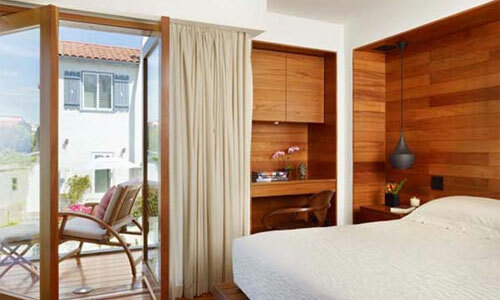Boarding is deservedly considered the most practical material for finishing various premises both inside and outside. It is natural, hides the unevenness of the walls, and looks very beautiful. All these qualities are achieved due to the rich choice of wood, but regarding its service life, it is only the person who is responsible for everything.

Which varnish or paint to use to protect the lining
The main advantages of a wooden lining are:
- practicality;
- simple installation;
- low cost;
- aesthetic properties;
- no pretreatment.
When the paneling adorns on the walls or ceiling of your house, the owner sooner or later have to ask the question: "How to cover the lining inside the house to ensure the maximum life of this material?" Usually, acrylic, alkyd and urethane lacquers, as well as oilpaints. Modern manufacturers present to customers as a colorless lacquer for lining and varnish with different shades.
Let's try to determine the perfect combination and talk in more detail about each of the coatings. Clear advantage on the side of acrylic varnishes and paints, because they know how to "breathe" and very elastic. AQUALAKI is environmentally friendly, therefore it has also proven to be an indispensable material when covering walls or ceilings indoors.
In turn, alkyd varnishes are used for painting floors, because they are quite solid and perfectly suitable for this purpose. Oil paints are well absorbed, but over time they quickly fade. Painting a lining requires the use of a special technology, based on this, it is best to use a conventional brush. Touch the wood should only the tip of the brush and start the procedure from top to bottom.
The varnish will lie flat and will not spoil the appearance of the material. To prevent the rapid aging of the wood from which the lining is made, it is necessary to use special protective equipment and carry out preliminary cleaning of the material, its impregnation, priming and painting.
Protection of lining in various areas
Painting the lining in the room is best acrylic varnish, it is hypoallergenic, quickly dries, protects against moisture, dirt and dust. Cover the lining in the house can also be transparent polyurethane lacquer, which will emphasize the naturalness of wood.
Thus, the question of how to cover the lining inside the house, we get a simple answer - one of the types of akvalak, giving the finishing material more beauty, highlighting and revealing its natural pattern. If you need to cover the lining on a balcony or loggia, then know that in such cases, the most common pine wood, which is first cleaned of chips, and then applied any antiseptic.
To cover the lining on the loggia you need two layers to protect it from high humidity. To obtain a better effect when choosing an inexpensive wood, the lacquer for the lining on the balcony can be toned. It is enough to add any shade to it, as a result, you will get a more expensive kind of lining.
And what to paint the lining at the cottage? In order to protect wood from direct sunlight, decorative glazes are used, which are more resistant to ultraviolet light. Cover the lining outside the house or cottage is recommended just such a composition.

The bamboo in the bath is best chosen from limes. This is facilitated by a number of reasons:
- linden with difficulty ignited;
- is good soundproof;
- for washing it will need ordinary detergents.
It is desirable to treat the bath immediately after construction, as the wood in such rooms is exposed to constant moisture and high temperature. For this purpose, it is recommended to cover the lining in the steam room with special oils on a natural basis, which can not adversely affect human health, and will not prevent the allocation of a pleasant lime flavor.
The dressing room is considered an important element of the sauna, because it's where people prefer to sit for a pleasant conversation, cooling down after a hot steam room. Therefore, when equipping a bath, it is necessary to try to keep this room as warm as possible and comfortable for staying in it.
For this you can cover the lining in the dressing room with a urethane-alkyd lacquer or a covering paint-antiseptic, the service life of which is more than 10 years. Both materials perfectly protect wood from fungus, mold, rot and have a dirt repellent and waterproof effect. That's why these materials are ideal for covering the lining in the bath.
Is it worth it?
And so, than to paint the lining we found out. Is it worth it to do at all? To answer this question, you need to consider where the lining will be used, and what you will do with it after some time. Basically, all types of paints and varnishes are equally used for finishing works, both outside and inside. The difference is only in the number of layers deposited.
The main drawback of the lack of coverage can be called only a greater likelihood of an imminent lining of the lining. If after a while the wood changed color, then it can be bleached with special bleaching agents for wood. Despite this, most experts are confident that the coating of wood material by any composition is necessary, first of all, to protect against atmospheric precipitation and sudden temperature changes.


